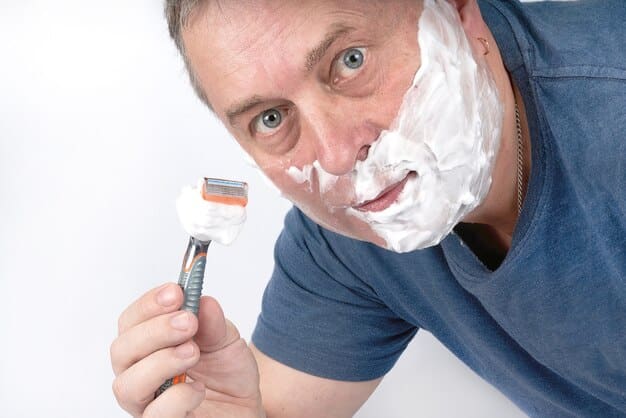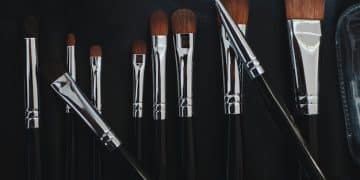Shaving Cream: 5 Ingredients to Avoid for Skin Health in 2025

Your shaving cream might be unknowingly harming your skin; identifying and avoiding five specific ingredients in 2025 is crucial for maintaining a healthy and irritation-free complexion.
For many, shaving is a daily ritual, a moment of personal grooming that can set the tone for the day. Yet, beyond the smooth finish, have you ever considered if
Shaving cream, often perceived as a simple lubricant, is a complex mixture of chemicals designed to create a protective barrier between the razor and your skin. Its primary functions are to soften the hair, lift it away from the skin, and provide lubrication to minimize friction and irritation. However, not all ingredients are created equal, and some commonly found in traditional formulations can have detrimental effects on your skin’s health over time. Understanding these components is the first step towards a healthier shave and a happier complexion. Historically, shaving creams were made from simple soap bases, but modern formulations have expanded to include a vast array of synthetic and natural compounds. These can range from emollients and humectants designed to hydrate the skin, to foaming agents that create that satisfying lather. While many of these are beneficial, some can act as irritants, allergens, or even disrupt the skin’s natural barrier. Consumers often overlook the ingredient list, assuming all products in a given category are inherently safe or equally beneficial. This assumption can lead to long-term skin issues, from persistent dryness and redness to more severe allergic reactions. The synergy or antagonism between these ingredients is what ultimately determines a product’s impact. A perfectly balanced formula can protect and nourish, while a poorly formulated one, even with seemingly benign ingredients, can cause problems. It’s not just about what's in the cream, but also how those components interact with each other and, more importantly, with your unique skin type. Therefore, an informed approach to ingredient selection becomes paramount, especially as we approach 2025 with an ever-increasing awareness of skin health. As we move towards 2025, consumer awareness regarding product ingredients is at an all-time high. The demand for cleaner, safer skincare products is pushing manufacturers to reformulate, but many conventional shaving creams still contain substances that are best avoided. These five ingredients, in particular, are notorious for causing irritation, dryness, and other adverse skin reactions, making them key candidates for elimination from your grooming routine. Sulfates, particularly Sodium Lauryl Sulfate (SLS) and Sodium Laureth Sulfate (SLES), are potent detergents commonly found in many personal care products, including shaving creams, due to their excellent foaming properties and low cost. While they create a rich lather, their detergency can strip the skin of its natural oils, leading to dryness, irritation, and a compromised skin barrier. For those with sensitive or dry skin, sulfates can exacerbate existing conditions, causing redness, flaking, and discomfort after shaving. Regular exposure can also disrupt the skin’s microbiome, making it more vulnerable to external aggressors. Parabens are a class of preservatives widely used in cosmetics and personal care products to prevent the growth of bacteria and mold. While effective at extending shelf life, their safety has been a subject of extensive debate for years. Concerns primarily stem from their ability to mimic estrogen in the body, leading to potential endocrine disruption. Although the amount absorbed from topical products is generally low, cumulative exposure from multiple sources is a concern for some. For skin health, parabens can also be a source of contact dermatitis for individuals with sensitivities, manifesting as itching, rashes, or inflammation. The term “fragrance” or “parfum” on an ingredient list can represent a complex cocktail of synthetic or natural chemicals, many of which are known allergens and irritants. Manufacturers are not required to disclose the specific components of their fragrance mixtures due to trade secret laws, leaving consumers in the dark about what they’re actually applying to their skin. For shaving creams, this is particularly problematic as the product is applied to freshly exfoliated skin, making it more susceptible to irritation. Symptoms can range from mild redness and burning to severe allergic reactions like contact dermatitis. Opting for fragrance-free or naturally scented products derived from essential oils (with caution, as some essential oils can also be sensitizing) is a safer bet for most skin types. Not all alcohols are bad; fatty alcohols like cetyl alcohol or stearyl alcohol are beneficial emollients. However, denatured alcohols such as ethanol, isopropyl alcohol, or alcohol denat., commonly used for their astringent properties or to help products dry quickly, can be highly damaging to the skin. They evaporate rapidly, taking with them essential skin lipids and moisture, leading to severe dryness, tightness, and a compromised skin barrier. This stripping effect can also trigger increased oil production in some skin types, leading to a vicious cycle of dehydration and breakouts. When scanning ingredient lists, look for “alcohol” or “alcohol denat.” and aim to avoid products where these appear high on the list. Phthalates are plasticizers often used in personal care products, including shaving creams, to enhance fragrance longevity or to make formulations more pliable. Like parabens, they are endocrine disruptors, meaning they can interfere with the body’s hormonal system. While direct correlation with specific skin damage from shaving cream use is less documented than for irritants like sulfates or alcohol, their systemic effects are a significant concern. They are often not explicitly listed but can be hidden under “fragrance” or “parfum.” The growing awareness of their potential health risks makes them a crucial ingredient to avoid for overall well-being, influencing skin health indirectly by affecting hormonal balance. By consciously avoiding these five ingredients, consumers can significantly reduce their risk of experiencing skin irritation, dryness, and other adverse reactions from their shaving cream. The shift towards cleaner formulations is not just a trend but a necessary evolution in personal care, prioritizing long-term skin health over immediate sensory appeal or cost-effectiveness. Making informed choices now will pave the way for healthier skin in 2025 and beyond. Even if you’re not well-versed in complex chemical names, your skin often sends clear signals when something isn’t right. Recognizing these signs is crucial for identifying if your shaving cream is causing more harm than good. A healthy post-shave experience should leave your skin feeling smooth, hydrated, and calm, not irritated or uncomfortable. Any deviation from this ideal state warrants a closer look at your product choices. One of the most immediate signs of a problematic shaving cream is persistent redness or inflammation after shaving. While some mild redness is normal due to the physical act of shaving, prolonged or intense redness that doesn’t subside within a short period signals an issue. Itching, burning, or stinging sensations, especially those that last for several hours, are strong indicators of irritation, often caused by harsh chemicals or sensitizers in the product. Observing these symptoms over time can help you pinpoint the culprits. It’s often beneficial to keep a mental note or even a small journal of how your skin feels after using new products. Patch testing new shaving creams on a small, less sensitive area of skin, like behind the ear or on the forearm, before applying them to your face, can also help identify potential irritants or allergens before a full-blown reaction occurs. Listening to your skin is the most effective way to ensure your grooming routine supports its health rather than hindering it. Shifting to shaving creams formulated with skin health in mind offers a multitude of benefits that extend far beyond simply avoiding irritation. These products prioritize gentle yet effective cleansing and lubrication, fostering a healthier skin environment both immediately after shaving and in the long term. Making this switch isn’t just about what you omit, but also about what you gain in terms of skin comfort and resilience. One of the most immediate advantages is a significant reduction in post-shave irritation. Products free from harsh sulfates, drying alcohols, and irritating fragrances ensure that your skin’s natural barrier remains intact, preventing moisture loss and protecting against environmental aggressors. This results in less redness, burning, and itching, transforming shaving from a potential chore into a more comfortable experience. Moreover, a robust skin barrier is less prone to breakouts and ingrown hairs, leading to a smoother, clearer complexion. Skin-friendly shaving creams often incorporate nourishing ingredients such as natural oils (e.g., coconut, jojoba, almond), glycerin, aloe vera, and botanical extracts. These components actively hydrate the skin, reduce friction, and provide a cushion for the blade, leading to a closer, more effortless shave. The emollients help soften the hair, allowing for a cleaner cut with fewer passes, which further minimizes tugging and irritation. The result is consistently soft, supple skin that feels genuinely moisturized, rather than stripped and tight. Furthermore, choosing products free from parabens and phthalates contributes to overall well-being, addressing concerns about endocrine disruptors and potential systemic effects. This holistic approach to personal care aligns with a growing consumer trend towards cleaner beauty, where transparency and safety are paramount. Ultimately, investing in skin-friendly shaving creams is an investment in your skin’s long-term health, leading to a more pleasant daily routine and a healthier appearance. Beyond selecting the right shaving cream, your entire shaving routine plays a crucial role in maintaining skin health. Even the best products can’t fully compensate for poor technique or overlooked steps. As we look towards 2025, refining these habits will be as important as ingredient awareness in achieving the ultimate shave and preserving your complexion. The foundation of a good shave begins before the blade even touches your skin. Always start with a clean face. Washing your face with a gentle cleanser removes dirt, oil, and dead skin cells, which can otherwise clog your razor and lead to irritation. A warm shower or applying a warm towel to your face for a few minutes before shaving helps to open pores and soften facial hair, making it easier to cut. This preparation reduces the need for excessive pressure, minimizing nugs and razor burn. Consider using a pre-shave oil, especially if you have sensitive skin or coarse hair. These oils create an additional layer of lubrication, further reducing friction and allowing the razor to glide more smoothly over the skin. Just a few drops massaged into damp skin before applying shaving cream can make a noticeable difference in comfort and outcome. Once your face is prepared and your skin-friendly shaving cream is applied, focus on your technique. Use a sharp, clean razor. Dull blades are a leading cause of irritation, razor bumps, and ingrown hairs. Replace your razor blade regularly—ideally every 5-7 shaves for disposable razors or cartridges, and after 2-3 uses for safety razors. Shave with the grain of your hair growth first to minimize pulling and irritation. For a closer shave, you can reapply cream and make a second pass across the grain, but never against it, especially if you have sensitive skin. Rinse your razor frequently throughout the shave to prevent it from clogging with hair and product. Use light, short strokes, letting the razor do the work rather than applying excessive pressure. Remember, multiple light passes are always better than one heavy pass. Patience is a virtue in shaving; rushing can lead to nicks and cuts. After rinsing off all shaving cream, pat your face dry gently with a clean towel; avoid harsh rubbing. Immediately follow up with a soothing, alcohol-free aftershave balm or moisturizer. This step is critical for restoring moisture to the skin and calming any immediate irritation. Look for products containing ingredients like aloe vera, chamomile, hyaluronic acid, or ceramides, which help to hydrate, repair, and protect the skin barrier. For those prone to ingrown hairs, a gentle exfoliating treatment a few times a week (not immediately after shaving) can help to keep pores clear and prevent hairs from curling back into the skin. Consistency in your routine, combined with thoughtful product choices, will lead to healthier, smoother skin and a more enjoyable shaving experience year-round. As we approach 2025, the landscape of personal care is continually evolving, with an increasing emphasis on transparency, sustainability, and targeted efficacy. This shift naturally extends to your shaving routine. Reformulating your approach isn’t just about swapping out one product for another; it’s about embracing a holistic philosophy that prioritizes skin health and environmental consciousness. The future of shaving is personalized, responsive, and deeply informed by scientific understanding and consumer demand for cleaner, safer options. The days of blindly trusting marketing claims are fading. The empowered consumer of 2025 is an informed one, actively researching ingredients, brand ethics, and product performance. This means taking the time to read ingredient labels, understanding what certain compounds do, and critically evaluating whether a product aligns with your skin’s needs and your personal values. Brands that are transparent about their formulations and sourcing will gain trust, while those clinging to outdated practices or problematic ingredients will likely see their market share dwindle. This consumer-driven demand is a powerful catalyst for positive change in the industry, pushing manufacturers towards better, safer alternatives. Beyond ingredients, the future of shaving also considers the environmental impact of products. This includes packaging (reducing plastic, opting for recyclable materials), manufacturing processes (ethical sourcing, energy efficiency), and the product’s ultimate biodegradability. Choosing brands that exemplify these values contributes to a healthier planet, aligning your grooming choices with broader sustainability goals. Transitioning to a reformulated shaving routine, therefore, involves a mindset shift. It requires a willingness to experiment, learn, and adapt, moving away from convenience-driven choices towards health-driven decisions. By proactively making these changes, you not only safeguard your skin but also contribute to a larger movement towards responsible and conscious consumption, shaping a brighter, healthier future for personal care in 2025 and beyond. Sulfates, like SLS and SLES, are strong detergents that create a rich lather but can strip your skin of its natural oils. This leads to dryness, irritation, and can compromise your skin’s protective barrier, especially for those with sensitive skin types. Opting for sulfate-free alternatives helps maintain skin hydration and reduces post-shave discomfort. Look out for “alcohol denat.,” “ethanol,” or “isopropyl alcohol” high on the ingredient list. These are drying alcohols. Fatty alcohols like “cetyl alcohol” or “stearyl alcohol” are beneficial and act as emollients, so they’re not a concern. The key is distinguishing between drying and nourishing forms of alcohol in product formulations. Synthetic fragrances, often listed as “parfum” or “fragrance,” are common allergens and irritants. They can cause redness, itching, burning, and even allergic contact dermatitis. Because companies aren’t required to disclose specific fragrance chemicals, it’s safer for sensitive skin to choose fragrance-free products. Natural essential oils can also be sensitizing. Parabens are preservatives that have raised concerns due to their potential as endocrine disruptors, mimicking estrogen in the body. While the amounts in individual products are small, cumulative exposure is a worry for some. For skin, they can occasionally trigger contact dermatitis. Many consumers prefer to avoid them as a precautionary measure for overall health. Phthalates are chemicals used as plasticizers or to prolong fragrance. They are considered endocrine disruptors, meaning they can interfere with hormonal systems. While not directly linked to skin damage from shaving cream, their broader health implications make them undesirable. They are often hidden under “fragrance,” so choosing fragrance-free is a double win. The seemingly simple act of shaving touches upon a complex interplay of skin health, product formulation, and personal well-being. By being an informed consumer and actively scrutinizing the ingredients in your shaving cream, especially by 2025, you empower yourself to make choices that genuinely benefit your skin. Avoiding common culprits like sulfates, parabens, artificial fragrances, drying alcohols, and phthalates is not just a trend but a foundational step towards a healthier, irritation-free shaving experience. Remember, your skin is a reflection of the care you give it, and choosing wisely ensures that your daily ritual contributes to its resilience and radiance for years to come.The Hidden World of Shaving Cream Ingredients
Beyond the Lather: Understanding Formulations
Five Ingredients to Actively Avoid in Shaving Creams by 2025

1. Sulfates (SLS, SLES)
2. Parabens (Methylparaben, Propylparaben, Butylparaben)
3. Fragrance (Parfum/Aroma)
4. Alcohol (Ethanol, Isopropyl Alcohol)
5. Phthalates (DBP, DEP, DEHP)
Understanding Your Skin’s Response: Signs of Damage
Common Indicators of Shaving Cream Irritation
The Benefits of Choosing Skin-Friendly Shaving Creams
A Healthier, Happier Shave Every Time

Tips for a Healthier Shaving Routine in 2025
Pre-Shave Preparation is Key
During the Shave: Technique Matters
Post-Shave Care and Hydration
Reformulating Your Routine: The Future of Shaving
Embracing Informed Consumerism
Key Point
Brief Description
🧴 Avoid Sulfates
Harmful foaming agents that strip natural skin oils, causing dryness and irritation.
🚫 Ditch Parabens
Preservatives potentially linked to endocrine disruption and skin sensitivities.
👃 Skip Artificial Fragrance
Common irritants masking undisclosed chemicals that can cause allergic reactions.
💧 Avoid Drying Alcohols
Ethanol & isopropyl alcohol dry out skin and compromise the natural protective barrier.
Frequently Asked Questions About Shaving Cream Ingredients
Conclusion





